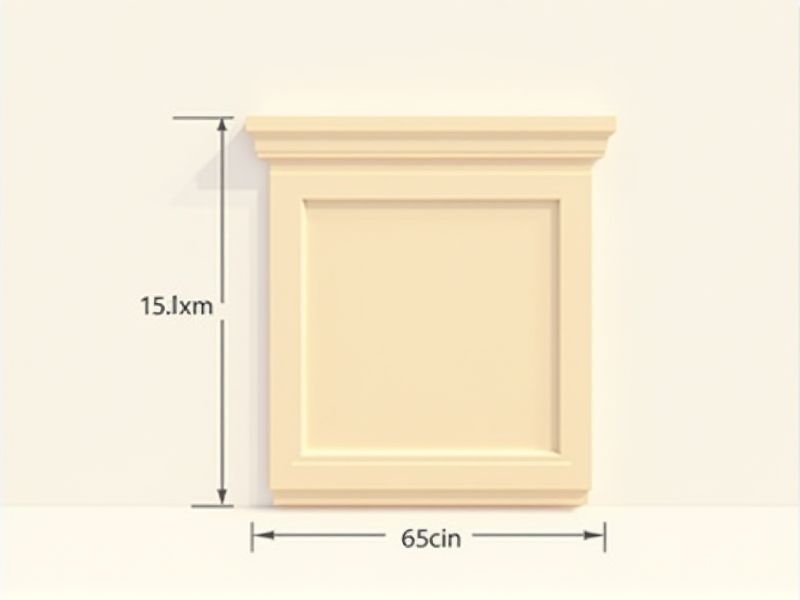
When planning a cabinet project, knowing standard cabinet door dimensions helps ensure a proper fit and streamlined installation. Most commonly, kitchen cabinet doors are 24 to 30 inches tall for base cabinets and 30 to 42 inches tall for wall cabinets, with typical widths ranging from 12 to 24 inches, depending on the cabinet's overall width. It's helpful to remember that overlay styles and frame thickness may also affect the final measurements you need. Always double-check manufacturer guidelines and measure your cabinetry before ordering or cutting doors to achieve the best results.
Height
The standard height for kitchen cabinet doors typically ranges from 30 to 42 inches. For base cabinets, a common height is 34.5 inches, allowing for a countertop height of 36 inches when including a 1.5-inch countertop overhang. Wall cabinet heights vary, often measuring between 30 and 42 inches, depending on your ceiling height and desired design. Ensuring the correct cabinet door height is essential for both functionality and aesthetic appeal in your kitchen layout.
Width
The standard width of cabinet doors typically ranges from 12 to 36 inches, depending on the cabinet style and design requirements. Most manufacturers produce doors in increments of 1 inch, allowing for a customized fit within your kitchen or workspace. A common practice is to match the cabinet door width to the cabinet's opening, ensuring a seamless appearance. When planning your cabinetry, consider that wider doors may require additional support hardware for durability and ease of use.
Thickness
The standard thickness for cabinet doors typically ranges from 0.5 to 1.0 inches, depending on the material and design. You may find that a 0.75-inch thickness offers an ideal balance of durability and aesthetic appeal, particularly for traditional styles. Increasing the thickness to 1.0 inch enhances sturdiness, making it suitable for custom or heavy-use cabinets. Always consider the door's weight and the hardware used, as these factors play a crucial role in ensuring longevity and functionality.
Overlay
The overlay of cabinet doors refers to how much the door covers the cabinet frame when closed, impacting both aesthetics and function. Typically, full overlay doors cover 100% of the cabinet's face frame, providing a seamless look with minimal visible cabinet sides, while partial overlay doors reveal some of the frame. Standard measurements for full overlay doors usually range between 1.5 inches to 2 inches, offering a modern and sleek appearance. When selecting overlay styles, consider your kitchen layout and desired design for optimal functionality and visual appeal.
Inset
Inset cabinet doors are crafted to fit within the cabinet's framework, providing a seamless and elegant appearance. Typically, the width of inset doors ranges from 1/2 inch to 3/4 inch thick, ensuring a sturdy construction. The precision in alignment not only enhances the visual appeal but also ensures optimal functionality, as these doors maintain a flush surface when closed. Investing in high-quality materials can elevate the aesthetic of your kitchen, making your inset cabinets a focal point of any home.
Rail Size
The standard size for cabinet door rails typically ranges from 2.5 inches to 3 inches in width, significantly affecting the overall aesthetics of the cabinetry. A larger rail size, such as 3 inches, provides a more robust and traditional appearance, suitable for classic or farmhouse styles, while a smaller rail of 2.5 inches offers a contemporary and sleek look. Your choice of rail size can also influence the durability of the door, with wider rails generally offering better structural support. Ensuring that rails are properly aligned and installed can enhance functionality, reducing the likelihood of warping or misalignment over time.
Stile Size
The standard size for cabinet door stiles typically ranges between 2 to 3 inches in width, depending on the overall design and structural requirements of the cabinetry. A wider stile, such as 3 inches, may offer greater durability and support, especially for larger doors or heavier materials. When considering your cabinet design, a 1/4-inch gap between doors creates a seamless look, allowing for easier alignment and operation. Opting for custom dimensions can also help achieve a tailored appearance that perfectly fits your space.
Hinge Spacing
Hinge spacing for cabinet doors typically ranges from 2 to 3 inches from the top and bottom edges of the door, providing optimal support and functionality. For standard-sized cabinets, using two hinges on each door is common, while larger doors may require three hinges for increased stability. Ensuring proper hinge alignment is crucial, often necessitating a gap of 1/8 inch between the door and the cabinet frame to facilitate smooth operation. Investing in quality hinges can enhance the lifespan of your cabinets, with premium options lasting over 50,000 openings.
Knob Placement
When designing your cabinet doors, ideal knob placement enhances both functionality and aesthetics. The standard height for knob installation is typically 36 to 48 inches from the floor, allowing for ergonomic access. If your cabinets are over 30 inches tall, place knobs approximately 2 to 3 inches from the top edge for optimal access. Ensure consistent spacing across all cabinets to create a unified look, contributing to a polished overall design.
Material Type
Cabinet doors are typically made from a variety of materials, each offering distinct advantages; popular options include solid wood, MDF (Medium Density Fiberboard), plywood, and particle board. For instance, solid wood provides exceptional durability and a timeless aesthetic, while MDF offers a smooth surface ideal for painting. Plywood combines strength with lightweight properties, making it a favored choice in high-quality constructions. When choosing your cabinet door material, consider factors such as cost, durability, and desired appearance, as these can significantly influence the overall quality and longevity of your cabinetry.
